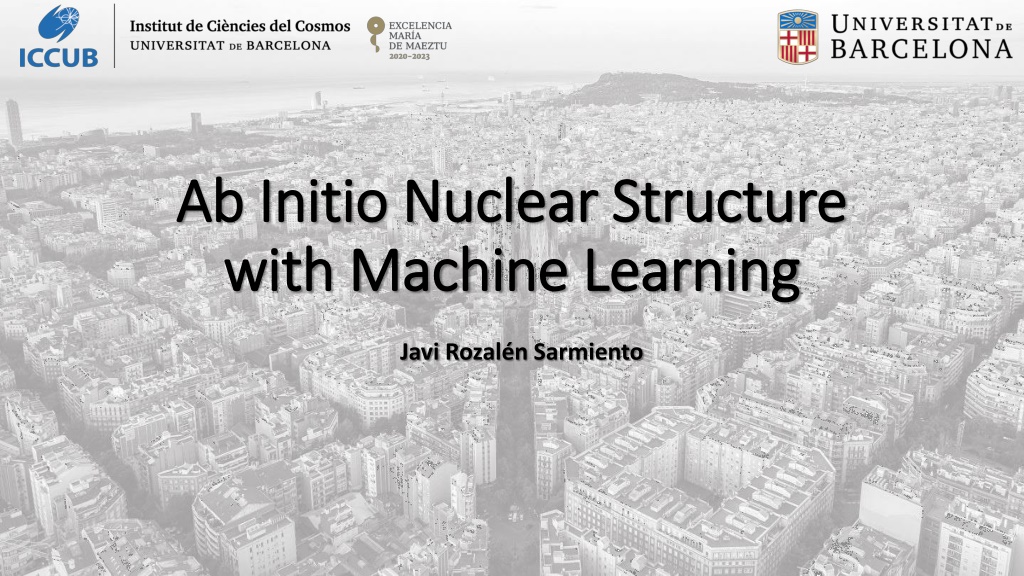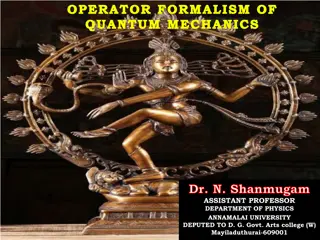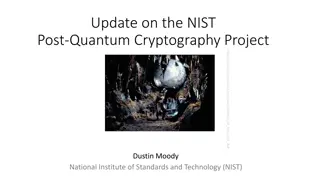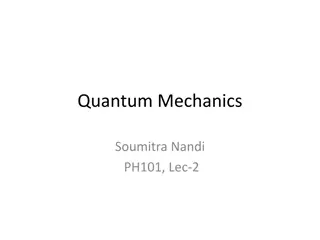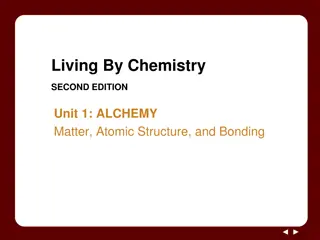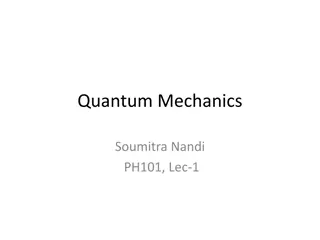Exploring Nuclear Structure with Machine Learning and Quantum Mechanics
Delve into the world of ab initio nuclear structure through the lens of machine learning and quantum mechanics. Discover the power of neural networks in approximating functions, live neural network training, symmetries in physical properties, and the role of group theory in understanding atomic nuclei. Unravel the complexities of the quantum many-body problem and explore the interplay between theoretical frameworks and computational methods in nuclear physics.
Download Presentation

Please find below an Image/Link to download the presentation.
The content on the website is provided AS IS for your information and personal use only. It may not be sold, licensed, or shared on other websites without obtaining consent from the author. Download presentation by click this link. If you encounter any issues during the download, it is possible that the publisher has removed the file from their server.
E N D
Presentation Transcript
Ab Initio Nuclear Ab Initio Nuclear Structure with with Machine Machine Learning Structure Learning Javi Rozal n Sarmiento
Ab Initio Nuclear Structure Lattice EFT IT-NCSM MR-IMSRG CCSD -CCSD VS-IMSRG ADC NQS [1] [1] H. Hergert, A Guided Tour of ab initio Nuclear Many-Body Theory, 2020
The Quantum Many-Body Problem: NQS Goal: Solve for the wave function of an atomic nucleus, ? |? How? Rayleigh-Ritz variational principle ??| ?|?? ??|?? ?? = ? ????,??, ,??d3Np ?GS ??,?? ??,?? ?? NQS Ansatz: ?NQS??,??, ,??;? ?? ?NQS(?;?) ?? L ? = ??,?? ?=1
Why Neural Networks? NNs have power : a neural network can approximate any continuous function [2], [3]. Space complexity: polynomial scaling of memory resources possibly! [2] G. Cybenko, Approximation by superpositions of a sigmoidal function, 1989 [3] K. Hornik M. Stinchcombe, H. White, Multilayer feedforward networks are universal approximators, 1989
Live Neural-Network Training ? ? N3LO interaction Deuteron ?=0? |?NQS ? ?=2? ?NQS ?hid= 20 neurons J. Keeble & A. Rios, Machine Learning the Deuteron, 2020 J. Keeble & A. Rios & J. Rozal n Sarmiento, 2024
Physical properties in NNs Particle exchange symmetry ? ?1,?2, ,?? = ? ?2,?1, ,?? Spherical symmetry ? ? ?( ?) = ? ? ? . . . Time-reversal symmetry ?( ?,?) = ? ?( ?,?) 6
Symmetries in Quantum Mechanics 1D Harmonic Oscillator ? =1 2?2+1 2??2?2 ?, ? = 0, ? parity Hydrogen Atom (Coulomb) 3 2 ? ?0 1 ?100?,?,? = 2?exp ??/?0 ? = 2 2??2 ??2 4? ? ???? 3 2 ? ?0 3 ?110?,?,? = 2?exp ??/?0 4?cos? ?, ?2= ?, ?? = 0 7
Group theory (in a nutshell) Irreducible Representation (irrep) Group ? ? = ?1? ?2? ??? ? = ? ?1,?2 ? ?1 ?2= ?3 ?} ?1? 0 0 = = ??? ??? sin? sin? cos? cos? 0 ? ?? = ? ?? 0 Linear Representation Schur s Lemma sin? sin? cos? cos? ? SO 2 ? ?? = ?1? irrep,? operator, ?1(?)? = ??1(?) ?1? 0 0 ?? ??= ??+? ? ??? ?? = ? ??+? ? = ?I,? number ? = ??? 8
Convolution is all you need Group convolution Group Equivariance [4, 5, 6] ? is equivariant / covariant under ? if: ? ?(? 1)? ?(?) ? ? ? = ? ? ? ? ? ? = ? (?)? ? ?1 ?2 ? ?-Conv ?-Conv ?-Conv ?? [4] T S Cohen and M Welling, Group Equivariant Convolutional Networks (2016) [5] T S Cohen and M Welling, Steerable CNNs (2016) [6] R Kondor and S Trivedi, On the Generalization of Equivariance and Convolution in Neural Networks to the Action of Compact Groups (2018)
Re-thinking previous work... Fermionic particle exchange, ?? Parity, /? = {?,?} Intuition Intuition ?NQS? ?NN? ?NN( ?) ?1(?1) ?1(?2) ?1(?3) ?2(?1) ?2(?2) ?2(?3) ?3(?1) ?3(?2) ?3(?3) ?NQS?1,?2,?3 = Group convolution Irreps of /? : ??? = 1 , Group convolution (Trivial rep) ??? = 1 1? ??(?1?1?2?2?3(?3)) ?NQS?1,?2,?3 = ??? = 1 (Sign rep) ??? = 1 , ? ?? ? Alternating representation of ?? ?+? ? ? + ?( ?) ? ? ? ? ?( ?) 10
Toy exemple: G = SN ? = 2 fermions, 1D HO Neural network ? = 25 channels G = 2 ? = 1 layer ?1 SN-Conv ?NQS(?1,?2) ?2 ?1 ?2 1? ??(?)? ? 1 ? SN
Conclusions and future outlook What about continuous groups (SU(2))? What is the computational cost? Compute whole nuclear spectrum at once
